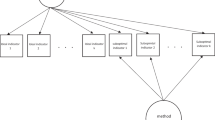Abstract
When handling missing data, a researcher should be aware of the mechanism underlying the missingness. In the presence of non-randomly missing data, a model of the missing data mechanism should be included in the analyses to prevent the analyses based on the data from becoming biased. Modeling the missing data mechanism, however, is a difficult task. One way in which knowledge about the missing data mechanism may be obtained is by collecting additional data from non-respondents. In this paper the method of re-approaching respondents who did not answer all questions of a questionnaire is described. New answers were obtained from a sample of these non-respondents and the reason(s) for skipping questions was (were) probed for. The additional data resulted in a larger sample and was used to investigate the differences between respondents and non-respondents, whereas probing for the causes of missingness resulted in more knowledge about the nature of the missing data patterns.
Similar content being viewed by others
References
Graham, J. W. & Donaldson, S.I. (1993). ‘Evaluating interventions with differential attrition: The importance of non-response mechanisms and use of follow-up data’, Journal of Applied Psychology 78: 119–128.
Huisman, M. (1998). ‘Missing data in behavioral sciences research: Investigation of a collection of data sets’, Kwantitatieve Methoden 57: 69–93.
Hunt, S. M., McKenna, S. P. & McEwen, J. (1993). ‘Nottingham health profile (NHP)’, in C. Koenig-Zahn, J. W. Furer & B. Tax (eds), Het meten van de gezondheidstoestand; 1-Algemene gezondheid. Assen: Van Gorcum, pp. 100–114.
Kempen, G. I. J. M., Doeglas, D. M. & Suurmeijer, Th. P. B. M. (1993). Het meten van problemen met zelfredzaamheid op verzorgend en huishoudelijk gebied met de Groningen Activity Restriction Scale (GARS): een handleiding [Measuring problems with independent functioning in daily life with the Groningen Activity Restriction Scale]. Groningen: Northern Center for Healthcare Research (NCG).
Krol, B. (1996). Beleefd wachten. Een onderzoek naar de wachtduur bij orthopedische patiënten [Waiting politely. Investigation of the duration of waiting lists for orthopaedic patients]. Groningen: Groeneland verzekeringen, Northern Center for Healthcare Research, University of Groningen.
Little, R. J. A. & Rubin, D. B. (1987). Statistical analysis with missing data. New York: Wiley.
Little, R. J. A. & Schenker, N. (1995). ‘Missing data’, in G. Arminger, C. C. Clogg & M. E. Sobel (eds), Handbook of Statistical Modeling for the Social and Behavioral Sciences. New York: Plenum Press, pp. 39–75.
Lousberg, H. B. (1994). ‘Chronic pain: Multiaxial diagnostics and behavioral mechanisms’, Ph.D. dissertation, University of Limburg.
Rao, P. S. R. S. (1983). ‘Callbacks, follow-ups, and repeated telephone calls’, in W. G. Madow, I. Olkin & D. B. Rubin (eds), Incomplete Data in Sample Surveys, Vol. II: Theory and Bibliographies. New York: Academic Press, pp. 33–44.
Rubin, D. B. (1987). Multiple Imputation for Non-response in Surveys. New York: Wiley.
Rights and permissions
About this article
Cite this article
Huisman, M., Krol, B. & Van Sonderen, E. Handling Missing Data by Re-approaching Non-respondents. Quality & Quantity 32, 77–91 (1998). https://doi.org/10.1023/A:1004338522505
Issue Date:
DOI: https://doi.org/10.1023/A:1004338522505



